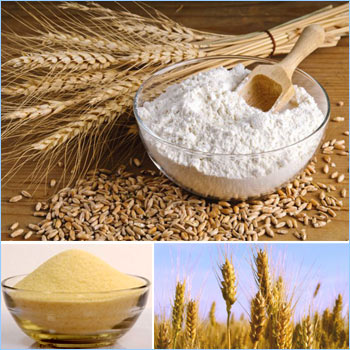 Wheat products make up a large portion of many diets. Current research shows that the nutrients and fiber in whole grains have beneficial effects on blood glucose, intestinal health and weight management. Diets rich in whole grains may also help prevent cardiovascular disease and some cancers.
Wheat products make up a large portion of many diets. Current research shows that the nutrients and fiber in whole grains have beneficial effects on blood glucose, intestinal health and weight management. Diets rich in whole grains may also help prevent cardiovascular disease and some cancers.
Normal wheat and durum wheat are different species of grass within the Triticum genus. Normal wheat is T. aestivum, a hexaploid species with 6 sets of chromosomes, whereas durum wheat is T. durum, a tetraploid form of wheat with 4 sets of chromosomes.
Grains of wheat have three parts: bran, germ and endosperm. The bran is the outer covering that contains most of the fiber in wheat grains. Bran also contains most of the B vitamins in wheat, along with minerals such as iron, magnesium and zinc. The endosperm is the starchy interior of the grain. This part of the grain has the most carbohydrates and protein. The germ contains fats, vitamin E and B vitamins. The oils in the germ cause whole wheat flour to spoil more quickly than white flour. The bran and germ also contain phytochemicals, or phytonutrients, that help protect against some chronic diseases.
Durum wheat has very high protein content relative to normal wheat but is low in gluten. Durum flour is mainly used to make pasta. Semolina is coarse-ground durum wheat mainly used in pasta. More highly refined durum flour is used in bread-making. Durum wheat has a higher protein content than soft varieties of wheat, which produces the gluten necessary to attain a proper texture in breads.
The nutritional value of durum flour depends on how it was processed. Whole wheat durum flour contains more nutrients than white durum flour. Refining wheat into white flour removes up to 75 of its phytochemicals during the milling process. Milling also removes some of the fats and fiber. Whole wheat flour contains more nutrients and fiber than white flour that doesn’t contain the bran or germ. Milled white flour is often enriched with minerals such as iron to improve its nutritional value. Because the germ has been removed from white flour, it has a longer shelf-life than whole wheat or stone-ground flour. In general, white flour is lower in calories, fat, protein, fiber, vitamins and minerals than whole wheat flour.
Maida is basically endosperm of wheat grain whereas wheat flour or atta contains husk bran, germ, and endosperm of wheat. Whole wheat flour is considered better for our health than white flour or maida. Maida is an Indian term for super refined flour obtained from wheat. While atta is the word most commonly used for the flour obtained from wheat. When whole wheat flour is further refined to separate the husk and the bran to leave behind a very fine flour, the resulting flour is called all-purpose flour or maida. This is a white flour that is the endosperm part of the wheat grain. It is basically just the carbohydrate content of wheat as it gets stripped of vitamins, fiber, and protein. Maida is also chemically bleached to leave it super white and very smooth.
The protein and gluten content of durum wheat is higher than that of maida and hence is a better choice than regular pasta. While choosing durum wheat pasta, ensure that it is whole grain durum because this wheat when pound to finer granules gives semolina which is not as healthy as the whole grains.
Semolina (also called Rava or Sooji) is nothing but a polished granular version of maida or wheat flour, their nutrient value is same. Semolina is the coarsely ground endosperm (no bran, no germ) of durum wheat. Its high protein content makes it ideal for making commercial pasta, and it can also be used to make bread. When semolina comes from softer types of wheats, it is white in color. In this case, the correct name is flour, not semolina. The same wheat (durum) is ground to make durum flour (finely ground) and semolina (coarsely ground). Nutritionally, they are the same as they come from the same plant.
Semolina is a name that is Italian in origin and refers to coarse flour obtained from wheat though flour from maize can also be labeled semolina. Semolina made from durum wheat is yellow in color. Meal produced from grains other than wheat may also be referred to as semolina, e.g. rice semolina, or corn semolina. Sooji is the name of a kind of flour obtained from wheat and used in northern parts of India. Rava is the name that is primarily used for semolina or sooji in southern parts of India though people refer to semolina as rava even in northern India.
